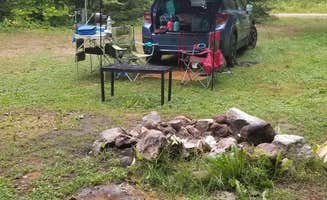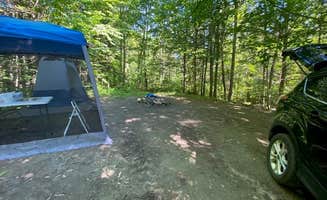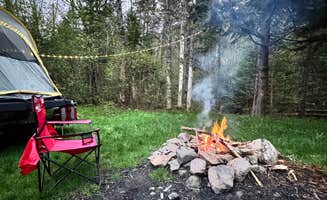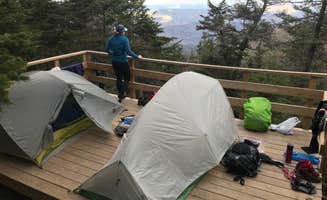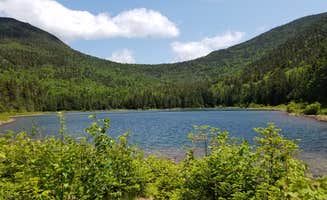Rustic camping near Chatham, New Hampshire offers primitive sites along forest roads and trails within the White Mountain National Forest. The region sits at elevations ranging from 700 to 4,000+ feet, creating dramatic temperature variations between valley campsites and mountain locations. Seasonal accessibility varies significantly, with many dispersed sites accessible only during summer and early fall months when forest roads remain open.
What to do
Hiking to mountain viewpoints: Guyot Shelter - Dispersed Camping offers backcountry access to some of the best ridge trails. "We got to the site, claimed our platform and hiked over to West Bond to catch a beautiful sunset," reports one hiker. The area provides exceptional connections to scenic peaks.
Fishing in local streams: Sites along Town Hall Road Dispersed offer excellent fishing access. "There are trout in the river and if you cross and go through the woods to the right there's some great spots to explore further," notes camper Erin H. Most riverfront sites provide direct water access for anglers.
Trail running on forest roads: The network of gravel roads provides excellent running routes with minimal traffic. "The road was not as bad as I anticipated," reports one camper at Town Hall Road. Many forest roads maintain moderate grades suitable for runners seeking elevation training.
What campers like
Sunlight access for solar equipment: At some sites, tree cover is minimal enough to allow for solar charging. "Few Solar/Starlink Options. If all we needed was a campsite with no solar or starlink, this would be 5 star review," notes a Town Hall Road camper. Another camper at Cherry Mountain Road Dispersed mentioned, "We were able to collect sunlight onto our solar panel from the site."
Noise isolation between sites: The spacing between many dispersed sites provides excellent sound privacy. One Cherry Mountain camper noted, "The camp site are all disbursed enough that we did not hear any other camping sounds at all. It was so quiet I could hear the sound of crow wings flapping as they flew by."
Protection from rainy weather: Some sites offer better drainage and protection during storms. "It was a great place for Rainy Camping. We went during a pouring rain storm and our site remained relatively dry. We even enjoyed a small fire the next day," shared a Town Hall Road visitor.
What you should know
Cell service limitations: Connectivity varies dramatically by location and carrier. At White Mountains Camping on Little Larry Road, one camper reported, "Just enough t-mobile/starlink signal to watch streaming and message, but wouldn't be enough for remote work." Another noted, "Site 4 and 5 get some cell service."
Seasonal stream reliability: Water sources can diminish or disappear late in summer. At Guyot Shelter, a camper observed, "There is a small stream to pump water from but it is seasonal." Always bring extra water or filtration equipment during dry periods.
Navigation challenges: Forest roads can be confusing and misleading for GPS systems. Campers should bring physical maps as backup. At White Mountains Camping on Little Larry Road, a visitor recommended going to "the White Mountain National Forest Picnic area off the main road about 5 minutes away" for better signal if needed.
Tips for camping with families
Multi-level camp setup: Some sites offer terrain variation perfect for family camping. At Tripoli Road one camper described versatile setups: "The sites vary from sites near and level with the road to ones set above or well below the road. Some are near a river, most are wooded."
Streamside entertainment: Water access provides natural play areas for children. "Great sites. Some right on water. First come first serve, can get busy," reports a Town Hall Road visitor. Shallow stream sections offer safe wading for supervised children.
Spacious group camping: For larger family gatherings, look for dispersed sites with ample room. "We found our spot which had some river access and it was gorgeous. It had an above and below spot which hosted our two tents," noted a Town Hall Road camper. Multiple tent pad areas within one site allow family groups to spread out comfortably.
Tips from RVers
Site scouting for larger vehicles: Most dispersed sites accommodate small to medium campers only. At Haystack Road, a camper advised, "There are 11 options, each completely separated from the others. We were in spot #1 which is nothing at all like the others. It is next to the Highway on a paved fire road."
Road condition awareness: Forest roads deteriorate throughout the season. "The road in is pretty rough and is not recommended for sedans or lower riding cars," cautions a visitor at Elbow Pond Road. Campers with trailers should scout roads before attempting access.
Limited turning radius: Many forest roads lack adequate turn-around spots for larger rigs. "Had to back my trailer about a quarter mile, so they could get out," reported one RVer at Elbow Pond Road when encountering another vehicle. Plan arrival during daylight hours when visibility is best for navigating narrow roads.


